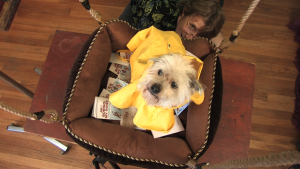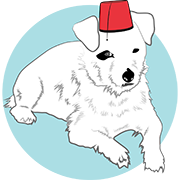Frankie doesn’t know it yet, but we’re about set out on a new adventure together: Training. And yes, this idea was inspired by his last adventure, being the star of a series of promotional videos for Am I Boring My Dog.
It’s not so much that I minded crouching down behind a table with my hands placed on my dog’s butt.

It’s a cute butt, and I’m reasonably limber, what with taking yoga and all. It’s just that I figure there’s got to be a better way than physical intervention, gentle or not, to get a small pup to lounge quietly in a dog bed.
But that’s just the immediate impetus for something I’ve been wanting to do for a long time. Since I’m a big advocate of training, I figure it’s time to put my money — and my energies — where my mouth is.
This led me to contemplate the definition of dog training. Ask ten people and you’re likely to get ten different answers. I can only tell you what it is — and isn’t — for me and for the trainers I respect.
What it’s not: Domination, rote instruction, or even, in many cases, problem solving.
What it is: Communication, leadership — and fun.
Why train if not to bend a pup to your will or change a behavior that doesn’t bother you?
To keep your dog alive
You may think your dog would never run out into traffic– until she does, at which point it’s too late to wish you’d trained her to respond immediately to a recall. And if your dog bites a stranger or two, no matter what the provocation, there’s a strong possibility she’ll have to be euthanized. Training may not reverse your dog’s impulse to chomp down when frightened, but it can help you read the warning signs and to keep her out of potentially dangerous situations.
To keep the lines of communication open
Good training has nothing to do with blind obedience or turning your pooch into an automaton. Rather, its goal is to let your dog know what you expect from her so she can behave accordingly. And vice versa. The better you understand each others’ signals, the less frustrated with each other you’ll be, and the deeper, and the more deeply rewarding, your relationship.
To keep your friends
Just because your dog’s eating habits don’t disturb you, others won’t necessarily appreciate your pup jumping up on the table and grazing from their plates at dinner parties. (Of course, depending on your cooking skills, she may be appreciated under the table, performing the classic function of dispatching unsuccessful culinary efforts.)
To keep yourself and your dog from being bored
Ongoing training is a great way for both you and your dog to stay alert and connected, and for the two of you to spend quality time together.
To keep others in awe
Most people, even those who like dogs, don’t realize the reach of canine capabilities, so it’s easy to impress them with pretty much anything beyond the basics of “sit” and “stay” and “down.” Don’t think of skill demonstrations as parlor tricks but, rather, as payback for the endless displays of toddler abilities you’ve had to endure. If your dog turns out to be more impressive than your friends’ toddlers, all the better (as long as you refrain from gloating).
Adapted from AM I BORING MY DOG?

“Communication, leadership — and fun.”
Nice description of training!
Thanks! I should warn you that commenting on my blog can be dangerous, often leading to requests for guest posts in your area of expertise (which just happens to be dog training….)
I already thought Frankie was pretty amazing after his balloon adventures, and I say gloat away when he outshines your friends’ toddlers, I bet he’s much better toilet trained than they are too!
A lot of times it is more a “People Training” exercise rather than “Dog Training” – a dog can be as frustrated as their owner when they don’t get what it is you want from them, and mixed signals from their owner only serve to make the situation worse. Once you are both speaking the same language the sky is the limit – oh wait, Frankie’s already been there…Have fun!
Thanks, Susanne. It’s actually going to be an interesting challenge because of the diabetes and thus the problem with food rewards between meals — and because Frankie is too stressed to even want food rewards out of doors. So we’ll see. But my not-so-secret (now!) plan is to see if I can find a local trainer who might want to co-blog with me about the process.
I agree with the dogs jumping up on people while they are eating. Some of my friends hate this more than the world and others think its cute.. so i was unsure how to teach my dog. But instead, i just went with the “no begging, or jumping up” while food is out drill. Very good write up.
Thank you. No begging or jumping up while food is out would cover a lot of territory– including their meals. Did you teach them that dog food is the kind that gets put on the floor?